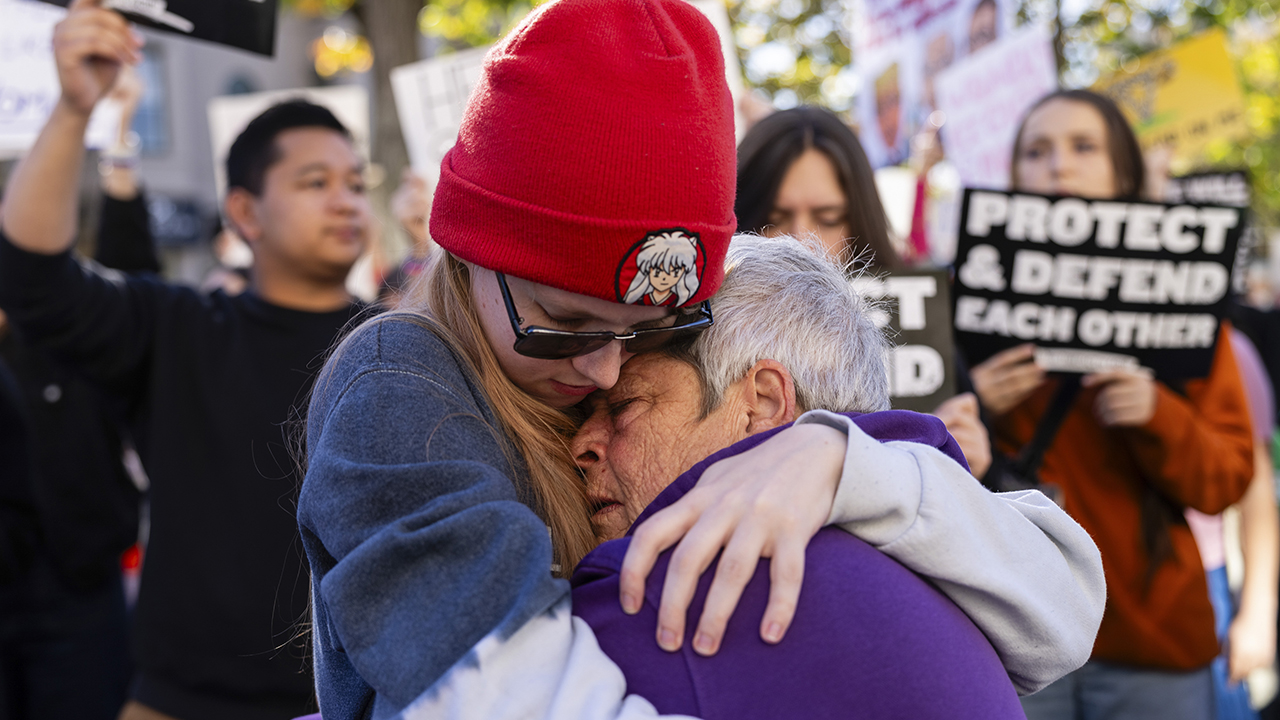FILE — Bev Pack, right, embraces a demonstrator at a rally organized by Women’s March near the Heritage Foundation in Washington, Nov. 9, 2024. Donald Trump’s grass-roots opponents search for a new playbook as they reckon with how little they accomplished during his first term. (Eric Lee/The New York Times)

- Grassroots movements face challenges in mobilizing against Trump's return, with many calling for new strategies beyond protests.
- Activists express disillusionment with past protest efforts, citing limited impact on policy changes during Trump's first term.
- Some supporters opt out of continued mass movements, questioning the effectiveness of traditional forms of dissent against the Trump administration.
Share
|
Getting your Trinity Audio player ready...
|
WASHINGTON — In the days after Donald Trump’s electoral victory, thousands of people revived the grassroots movement that opposed his first term in office.
Marchers in Manhattan took over streets carrying a block-wide banner that read, “We Won’t Back Down.” Activists in Los Angeles and Chicago decried Trump’s abortion and immigration policies and vowed to descend on Washington to protest his inauguration in January.
But participants noted that Trump had not appeared to be swayed by protests, petitions, hashtag campaigns or other tools of mass dissent. Many have been calling for a fresh playbook.
“I thought the first women’s march would be a turning point,” said Laura Bartek, 45, a nurse from Virginia, referring to the protest — with nearly half a million people — that took place after Trump’s 2017 inauguration.
“To be here eight years later with these signs,” Bartek said during a recent protest in Washington, “it breaks my heart.”
“I keep getting emails to sign petitions,” said Leslie Mac, a digital strategist and communications expert who works with grassroots organizations. “These people coming to the White House don’t care about petitions. They don’t care how many people sign them. They don’t care what they say.”
Related Story: Judge Delays Trump Hush Money Sentencing in Order to Decide Where Case Should ...
The first Trump presidency spawned the largest protests the country had seen in half a century.
But not everyone wants to participate in another four years of mass movement work. When Women’s March shared information about an upcoming rally on Instagram, one person responded, “No im tired, yall have fun though.” (Women’s March later hid some of the pushback and limited who could respond to a handful of posts.)
On TikTok, plans for the march were met with memes of women saying, “Get somebody else to do it.” “This is an opportunity for a national brunch day for the 93%,” said one user, referring to the 93% of Black women who exit polls suggested had voted for Vice President Kamala Harris.
Others questioned whether the previous protests had resulted in substantial concessions.
Related Story: Automakers to Trump: Please Require Us to Sell Electric Vehicles
Trump’s three Supreme Court appointees overturned Roe v. Wade after nearly half a million pink-hatted participants in the first women’s march called for upholding abortion rights. The Trump administration ultimately imposed a travel ban — barring most travelers from five majority Muslim countries, North Korea and Venezuela — even though large swaths of the public initially condemned the action. The demonstrations that erupted after the killing of George Floyd by police officers in Minneapolis did not result in federal police reform laws under either Trump or President Joe Biden.
And Biden has largely ignored fierce protests over Israel’s mass killing of Palestinians in the Gaza Strip.
The left’s failure to shift policy has contrasted markedly with past mass movements that helped spur progressive legislative changes.
—
This article originally appeared in The New York Times.
By Katie Benner/Eric Lee
c.2024 The New York Times Company



















